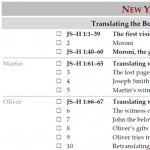
A checklist for reading the Doctrine and Covenants in chronological order with Joseph Smith—History and the Articles of Faith
Here is a handout I’ve created to help users read the Doctrine and Covenants in chronological order, in conjunction with Joseph Smith—History and the Articles of Faith. It can be used with the rest of my collection of handouts for giving an overview of the Doctrine and Covenants. It basically provides the same information as the chronological reading diagram, only in checklist form.
It’s a two-page letter-size PDF file, so if you print it front-and-back, it will fit on one sheet of paper. You can download the color version or the black-and-white versions, which I’ve tried to shade just right for photocopying.
This checklist might be especially handy for Gospel Doctrine teachers and class members in the years we study the D&C, as well as for those involved in seminary and institute classes.
Reading in order
This checklist takes the form of a table containing each section number with a suggested title I came up with, followed by the date of reception and the number of verses in the section. However, instead of listing the sections in numerical order (i.e., the order they’re found in the scriptures), I put them in chronological order. In that way, it’s similar to the Chronological Order of Contents in your print edition of the Doctrine and Covenants, although my dates differ because I’ve used more recent research from the Joseph Smith Papers project. I also included all passages from Joseph Smith—History and the Articles of Faith, broken up and inserted where they fit chronologically. This way, you can read all three books of scripture together in the sequence they were produced (I think everyone should try that at some point).
I included the verse count in case some users wanted to use that information to pace themselves or set reading blocks of roughly uniform length (by the way, the D&C’s halfway point verse-wise falls in the middle of section 76, which, I’m guessing, is why the BYU D&C classes chop the book into two semesters right after that section).
Headings and subheadings
I also divided and subdivided the sections to help you get a handle on the basic structure of Church history and of the Doctrine and Covenants. These are the same divisions used in the D&C Structured Edition and on the Divisions of Sections handout.
 The first level (dark grey strips, small-caps lettering) is geographical and is pretty objective (2–40 New York; 41–112 Ohio; 113–123 Missouri; 124–135 Illinois; 136–OD-2 The West). Because of various journeys by Joseph Smith, there are a few exceptions within each geographical grouping (e.g., the Prophet was living in Pennsylvania when sections 3–13 were received).
The first level (dark grey strips, small-caps lettering) is geographical and is pretty objective (2–40 New York; 41–112 Ohio; 113–123 Missouri; 124–135 Illinois; 136–OD-2 The West). Because of various journeys by Joseph Smith, there are a few exceptions within each geographical grouping (e.g., the Prophet was living in Pennsylvania when sections 3–13 were received). The second level (light grey strips, lower-case lettering) is more thematic than geographical. For instance, sections 21–28 include several revelations related to the organizational structure of the Church, and sections 98–106 include several revelations related to Zions Camp, with some exceptions in both cases. There is some subjectivity to the groupings, and I would be very interested in hearing other people’s proposals for alternate divisions and titles.
The second level (light grey strips, lower-case lettering) is more thematic than geographical. For instance, sections 21–28 include several revelations related to the organizational structure of the Church, and sections 98–106 include several revelations related to Zions Camp, with some exceptions in both cases. There is some subjectivity to the groupings, and I would be very interested in hearing other people’s proposals for alternate divisions and titles. The third level (light grey lines, light grey lettering) is even more subjective. It was my attempt at finding smaller thematically-similar groupings of revelations with the second-level groupings. Some groupings are clear-cut, such as sections 60–62 which all came during the return journey to Ohio from the first conference in Missouri, or sections 94–97 which all related to the construction plans for the Kirtland Temple. Others are admittedly ad hoc or are only loosely related—so much so that while I indicated the division point with a grey line, I couldn’t really come up with a label since the themes were so disparate. I’d love to hear your ideas for naming them!
The third level (light grey lines, light grey lettering) is even more subjective. It was my attempt at finding smaller thematically-similar groupings of revelations with the second-level groupings. Some groupings are clear-cut, such as sections 60–62 which all came during the return journey to Ohio from the first conference in Missouri, or sections 94–97 which all related to the construction plans for the Kirtland Temple. Others are admittedly ad hoc or are only loosely related—so much so that while I indicated the division point with a grey line, I couldn’t really come up with a label since the themes were so disparate. I’d love to hear your ideas for naming them!
Hopefully this kind of dividing and subdividing helps readers keep track of broader patterns and events as they read, making it easier to remember the context—a particularly difficult task in this book of scripture, since it lacks a storyline. For an example of one pattern, see Figure 8: Separation as Migration, on page 39 of my monograph on spiritual death.